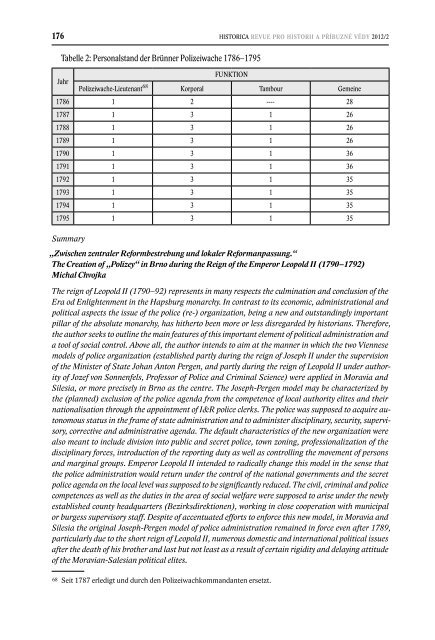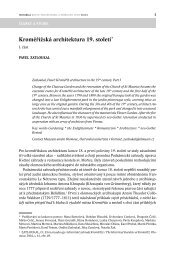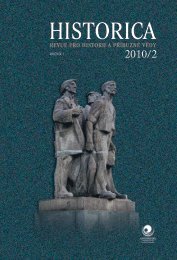Stáhnout PDF/Download - Ostravská univerzita v Ostravě
Stáhnout PDF/Download - Ostravská univerzita v Ostravě
Stáhnout PDF/Download - Ostravská univerzita v Ostravě
You also want an ePaper? Increase the reach of your titles
YUMPU automatically turns print PDFs into web optimized ePapers that Google loves.
176 HISTORICA Revue pro historii a příbuzné vědy 2012/2<br />
Tabelle 2: Personalstand der Brünner Polizeiwache 1786–1795<br />
Jahr<br />
FUNKTION<br />
Polizeiwache-Lieutenant 68 Korporal Tambour Gemeine<br />
1786 1 2 ---- 28<br />
1787 1 3 1 26<br />
1788 1 3 1 26<br />
1789 1 3 1 26<br />
1790 1 3 1 36<br />
1791 1 3 1 36<br />
1792 1 3 1 35<br />
1793 1 3 1 35<br />
1794 1 3 1 35<br />
1795 1 3 1 35<br />
Summary<br />
„Zwischen zentraler Reformbestrebung und lokaler Reformanpassung.“<br />
The Creation of „Polizey“ in Brno during the Reign of the Emperor Leopold II (1790–1792)<br />
Michal Chvojka<br />
The reign of Leopold II (1790–92) represents in many respects the culmination and conclusion of the<br />
Era od Enlightenment in the Hapsburg monarchy. In contrast to its economic, administrational and<br />
political aspects the issue of the police (re-) organization, being a new and outstandingly important<br />
pillar of the absolute monarchy, has hitherto been more or less disregarded by historians. Therefore,<br />
the author seeks to outline the main features of this important element of political administration and<br />
a tool of social control. Above all, the author intends to aim at the manner in which the two Viennese<br />
models of police organization (established partly during the reign of Joseph II under the supervision<br />
of the Minister of State Johan Anton Pergen, and partly during the reign of Leopold II under authority<br />
of Jozef von Sonnenfels, Professor of Police and Criminal Science) were applied in Moravia and<br />
Silesia, or more precisely in Brno as the centre. The Joseph-Pergen model may be characterized by<br />
the (planned) exclusion of the police agenda from the competence of local authority elites and their<br />
nationalisation through the appointment of I&R police clerks. The police was supposed to acquire autonomous<br />
status in the frame of state administration and to administer disciplinary, security, supervisory,<br />
corrective and administrative agenda. The default characteristics of the new organization were<br />
also meant to include division into public and secret police, town zoning, professionalization of the<br />
disciplinary forces, introduction of the reporting duty as well as controlling the movement of persons<br />
and marginal groups. Emperor Leopold II intended to radically change this model in the sense that<br />
the police administration would return under the control of the national governments and the secret<br />
police agenda on the local level was supposed to be significantly reduced. The civil, criminal and police<br />
competences as well as the duties in the area of social welfare were supposed to arise under the newly<br />
established county headquarters (Bezirksdirektionen), working in close cooperation with municipal<br />
or burgess supervisory staff. Despite of accentuated efforts to enforce this new model, in Moravia and<br />
Silesia the original Joseph-Pergen model of police administration remained in force even after 1789,<br />
particularly due to the short reign of Leopold II, numerous domestic and international political issues<br />
after the death of his brother and last but not least as a result of certain rigidity and delaying attitude<br />
of the Moravian-Salesian political elites.<br />
68 Seit 1787 erledigt und durch den Polizeiwachkommandanten ersetzt.










